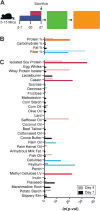Interactions Between Diet and the Intestinal Microbiota Alter Intestinal Permeability and Colitis Severity in Mice
- PMID: 29174952
- PMCID: PMC5847454
- DOI: 10.1053/j.gastro.2017.11.030
Interactions Between Diet and the Intestinal Microbiota Alter Intestinal Permeability and Colitis Severity in Mice
Abstract
Background & aims: It is not clear how the complex interactions between diet and the intestinal microbiota affect development of mucosal inflammation or inflammatory bowel disease. We investigated interactions between dietary ingredients, nutrients, and the microbiota in specific pathogen-free (SPF) and germ-free (GF) mice given more than 40 unique diets; we quantified individual and synergistic effects of dietary macronutrients and the microbiota on intestinal health and development of colitis.
Methods: C56BL/6J SPF and GF mice were placed on custom diets containing different concentrations and sources of protein, fat, digestible carbohydrates, and indigestible carbohydrates (fiber). After 1 week, SPF and GF mice were given dextran sulfate sodium (DSS) to induce colitis. Disease severity was determined based on the percent weight change from baseline, and modeled as a function of the concentration of each macronutrient in the diet. In unchallenged mice, we measured intestinal permeability by feeding mice labeled dextran and measuring levels in blood. Feces were collected and microbiota were analyzed by 16S rDNA sequencing. We collected colons from mice and performed transcriptome analyses.
Results: Fecal microbiota varied with diet; the concentration of protein and fiber had the strongest effect on colitis development. Among 9 fiber sources tested, psyllium, pectin, and cellulose fiber reduced the severity of colitis in SPF mice, whereas methylcellulose increased severity. Increasing dietary protein increased the density of the fecal microbiota and the severity of colitis in SPF mice, but not in GF mice or mice given antibiotics. Psyllium fiber reduced the severity of colitis through microbiota-dependent and microbiota-independent mechanisms. Combinatorial perturbations to dietary casein protein and psyllium fiber in parallel accounted for most variation in gut microbial density and intestinal permeability in unchallenged mice, as well as the severity of DSS-induced colitis; changes in 1 ingredient could be offset by changes in another.
Conclusions: In an analysis of the effects of different dietary components and the gut microbiota on mice with and without DSS-induced colitis, we found complex mixtures of nutrients affect intestinal permeability, gut microbial density, and development of intestinal inflammation.
Keywords: IBD; Microbiota; Mouse Models; Systems Biology.
Copyright © 2018 AGA Institute. Published by Elsevier Inc. All rights reserved.
Figures




Similar articles
-
Enteric Delivery of Regenerating Family Member 3 alpha Alters the Intestinal Microbiota and Controls Inflammation in Mice With Colitis.Gastroenterology. 2018 Mar;154(4):1009-1023.e14. doi: 10.1053/j.gastro.2017.11.003. Epub 2017 Nov 11. Gastroenterology. 2018. PMID: 29133078
-
Diet Modifies Colonic Microbiota and CD4+ T-Cell Repertoire to Induce Flares of Colitis in Mice With Myeloid-Cell Expression of Interleukin 23.Gastroenterology. 2018 Oct;155(4):1177-1191.e16. doi: 10.1053/j.gastro.2018.06.034. Epub 2018 Jun 15. Gastroenterology. 2018. PMID: 29909020 Free PMC article.
-
Barley Leaf Insoluble Dietary Fiber Alleviated Dextran Sulfate Sodium-Induced Mice Colitis by Modulating Gut Microbiota.Nutrients. 2021 Mar 5;13(3):846. doi: 10.3390/nu13030846. Nutrients. 2021. PMID: 33807544 Free PMC article.
-
Food Components and Dietary Habits: Keys for a Healthy Gut Microbiota Composition.Nutrients. 2019 Oct 7;11(10):2393. doi: 10.3390/nu11102393. Nutrients. 2019. PMID: 31591348 Free PMC article. Review.
-
The Role of Diet in the Pathogenesis and Management of Inflammatory Bowel Disease: A Review.Nutrients. 2020 Dec 31;13(1):135. doi: 10.3390/nu13010135. Nutrients. 2020. PMID: 33396537 Free PMC article. Review.
Cited by
-
Oral administration of human carbonic anhydrase I suppresses colitis in a murine inflammatory bowel disease model.Sci Rep. 2022 Oct 26;12(1):17983. doi: 10.1038/s41598-022-22455-y. Sci Rep. 2022. PMID: 36289244 Free PMC article.
-
Intake of Dietary Fiber, Fruits, and Vegetables and Risk of Diverticulitis.Am J Gastroenterol. 2019 Sep;114(9):1531-1538. doi: 10.14309/ajg.0000000000000363. Am J Gastroenterol. 2019. PMID: 31397679 Free PMC article.
-
Microbiota-dependent and -independent effects of dietary fibre on human health.Br J Pharmacol. 2020 Mar;177(6):1363-1381. doi: 10.1111/bph.14871. Epub 2019 Dec 12. Br J Pharmacol. 2020. PMID: 31663129 Free PMC article. Review.
-
Environmental and Microbial Factors in Inflammatory Bowel Disease Model Establishment: A Review Partly through Mendelian Randomization.Gut Liver. 2024 May 15;18(3):370-390. doi: 10.5009/gnl230179. Epub 2023 Oct 10. Gut Liver. 2024. PMID: 37814898 Free PMC article. Review.
-
GPR15-C10ORF99 functional pairing initiates colonic Treg homing in amniotes.EMBO Rep. 2022 Feb 3;23(3):e53246. doi: 10.15252/embr.202153246. Epub 2021 Dec 23. EMBO Rep. 2022. PMID: 34939731 Free PMC article.
References
-
- Lee D, Baldassano RN, Otley AR, et al. Comparative Effectiveness of Nutritional and Biological Therapy in North American Children with Active Crohn’s Disease. Inflamm Bowel Dis. 2015;21:1786–93. - PubMed
-
- Lewis JD, Abreu MT. Diet as a Trigger or Therapy for Inflammatory Bowel Diseases. Gastroenterology. 2017;152:398–414. - PubMed
-
- Zachos M, Tondeur M, Griffiths AM. Enteral nutritional therapy for induction of remission in Crohn’s disease. Cochrane Database Syst Rev. 2007 - PubMed
Publication types
MeSH terms
Substances
Grants and funding
LinkOut - more resources
Full Text Sources
Other Literature Sources
Medical

